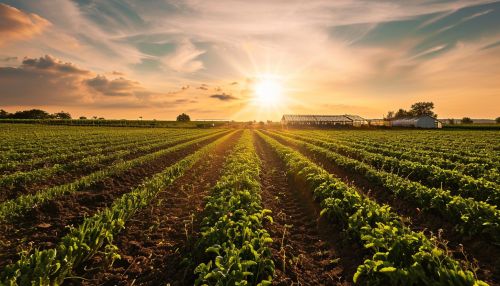Biotechnology in Agriculture
Introduction
Biotechnology in agriculture is a rapidly evolving field that involves the use of scientific tools and techniques, including genetic engineering, molecular markers, molecular diagnostics, vaccines, and tissue culture, to modify living organisms: plants, animals, and microorganisms. The application of biotechnology in agriculture has resulted in significant benefits to farmers, producers, and consumers.


History and Development
The history of biotechnology in agriculture dates back to the domestication of plants and animals. Early farmers selected the best looking plants and seeds to sow each year, indirectly leading to the cultivation of crops that were larger or had other desirable traits. This primitive form of biotechnology was largely trial and error, with knowledge passed down through generations.
The development of Mendel's laws of inheritance in the mid-19th century provided the first scientific explanation for this process. This understanding of heredity opened the door for scientists to manipulate traits in organisms by crossbreeding, a process known as hybridization.
The discovery of Deoxyribonucleic acid (DNA) and its role in genetic inheritance in the mid-20th century was a major breakthrough in the field of biotechnology. This led to the development of techniques that allowed scientists to manipulate the genetic material of an organism, leading to the creation of genetically modified organisms (GMOs).
Genetic Engineering
Genetic engineering is a key aspect of agricultural biotechnology. It involves the direct manipulation of an organism's genome using biotechnology. This is different from traditional crossbreeding, where genes are mixed randomly. Genetic engineering allows for the transfer of individual genes from one organism to another, also between non-related species.
The most common form of genetic engineering involves the insertion of new genetic material at an arbitrary location in the host genome. This is known as rDNA technology, and it was this technique that led to the creation of the first genetically modified plant in the early 1980s.
Genetically modified crops (GM crops) are now widely used around the world, with significant benefits in terms of yield and cost of production. However, the use of GM crops is also controversial, with concerns about potential impacts on human health and the environment.
Molecular Markers and Diagnostics
Molecular markers are fragments of DNA that are associated with a certain trait. They are used in plant and animal breeding to select for specific traits, such as disease resistance or drought tolerance. This technique, known as marker-assisted selection (MAS), allows breeders to identify and select for specific genetic traits without needing to grow and observe the organism.
Molecular diagnostics are used to identify and quantify specific sequences of DNA or RNA that may be associated with disease. These techniques are used in agriculture to diagnose plant and animal diseases, allowing for early detection and treatment.
Tissue Culture
Tissue culture is another important technique in agricultural biotechnology. It involves the in vitro cultivation of cells, tissues, organs, or whole plants. This technique is used for the propagation of plants with desirable traits, and for the production of plants that are disease-free.
Tissue culture is also used in the production of transgenic plants. In this process, cells are first transformed with the desired gene, and then cultured in vitro to form a whole plant.
Vaccines
Vaccines are another important application of biotechnology in agriculture. Traditional vaccines are produced by growing the disease-causing organism in the lab, inactivating it, and then injecting it into the animal. This stimulates the animal's immune system to produce antibodies against the disease.
Recombinant DNA technology has allowed for the development of genetically engineered vaccines, where a gene from the disease-causing organism is inserted into a harmless host organism. The host organism then produces the disease antigen, which can be used as a vaccine.
Future Perspectives
The future of agricultural biotechnology is promising, with many exciting developments on the horizon. Advances in genetic engineering techniques, such as CRISPR-Cas9, are opening up new possibilities for the precise editing of genomes. This could lead to the development of crops with improved traits, such as increased nutritional content, resistance to pests and diseases, and tolerance to environmental stresses.
There is also growing interest in the use of biotechnology to develop sustainable agricultural practices. This includes the development of crops that require less water or fertilizers, and the use of genetically engineered insects for pest control.
However, the future of agricultural biotechnology is also likely to be shaped by societal attitudes and regulatory frameworks. Public acceptance of genetically modified crops varies widely around the world, and this will continue to influence the development and adoption of new technologies.
